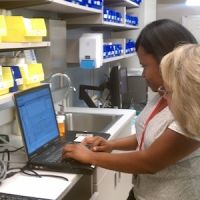In a national clinical trial led by Joslin Diabetes Centre’s Beetham Eye Institute, ultrawide field (UWF) scanning technology significantly improved the ability of experts at a remote central location to identify diabetic retinopathy in a patient, and to judge whether the eye disease warranted referring the patient to an ophthalmologist for further care.
The national trial confirms findings of earlier research on Beetham patients with UWF imaging, says Paolo Silva, M.D., staff ophthalmologist and assistant chief of telemedicine, and lead author on a paper appearing in the journal Ophthalmology.
“These data demonstrate that when we deploy this technology in a community-based setting, we can achieve the same magnitude of reduction in ungradeable images and increased identification of eye disease as we saw in the academic research environment,” Silva says.
Examining more than 25,000 patients in the U.S. Indian Health Service-Joslin Vision Network (IHS-JVN) telemedicine programme, the researchers showed that UWF imaging dropped the number of ungradeable eye images by 81 percent compared to imaging using traditional digital retinal photographs.
The IHS-JVN national network evaluates over 18,000 patients each year. Improved imaging for that total population would translate to almost 4,000 patients who otherwise would have been given urgent referrals for care that ultimately would not have been needed, Silva says.
Traditional Early Treatment Diabetic Retinopathy Study (ETDRS) photography, which has remained the gold standard for diabetic eye imaging for decades, combines seven retinal photographs to image about 30 percent of the retina. In contrast, “with UWF, we’re able to see 82 percent of the retina in a single retinal image, with high resolution,” Silva says.
The chances that UWF imaging will produce ungradeable retinal images increases with age, partly because people with diabetes are at a much higher risk for developing cataracts than people the same age without diabetes, says Silva. In the study, UWF imaging did perform significantly better with older eyes than did conventional retinal imaging.
Additionally, the study discovered that UWF imaging detected peripheral retinal disease in about 10 percent of the patients. These peripheral lesions are located outside the retinal area captured by ETDRS images. They can help ophthalmologists predict which eyes are most likely to progress to more advanced stages of diabetic retinopathy, as Joslin researchers reported in another Ophthalmology paper last year.
The IHS-JVN eye telemedicine programme covers 97 health care facilities in 25 states, gathering patient images for evaluation at a centre in Phoenix, Arizona. The collection sites vary from large academic medical centres to mobile imaging stations in locations as remote as the Arctic Circle or the Grand Canyon. “The network brings the technology to where the patients are,” Silva says. “This is the true essence of teleophthalmology for diabetic retinopathy; you go to patients and you evaluate them remotely.”
“These often are very isolated communities,” says Lloyd Paul Aiello, M.D., Ph.D., Director of the Beetham Institute, Professor of Ophthalmology at Harvard Medical School and senior author on the paper. “For this population to receive eye care, many have to take an airplane to a major medical center many miles away. That is a huge expense in terms of their time and travel costs.”
UWF camera systems remain much costlier than conventional retinal cameras, with price tags that can exceed $70,000. However, the latest study underlines the significant advantages they can provide, says Aiello.
“Utilising this new type of camera technology, we can more easily obtain the images, we can read the retinal images faster, we have fewer images that are unusable, and we pick up more disease than we could in the past,” he sums up. “And we have now shown this substantial benefit in a large real-world setting.”
A broader national comparison study is now underway in the Diabetic Retinopathy Clinical Research Network, with its initial results expected by late 2016. “If that study also shows that we can use this technology reliably, we expect this type of imaging will used much more commonly,” Dr. Aiello says.
Source: Joslin Diabetes CentreImage Credit: Joslin Diabetes Centre



























